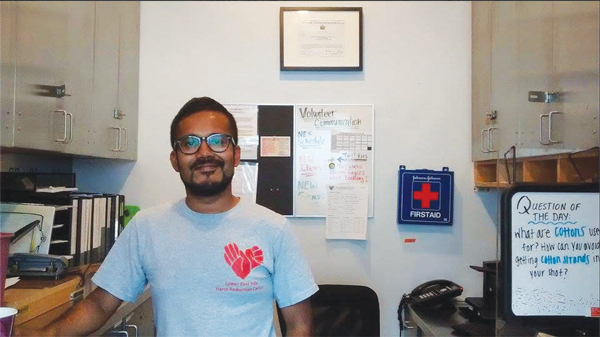
BY CLARISSA-JAN LIM | Every Monday through Saturday, a varying number of people frequent the Lower East Side Harm Reduction Center’s office on Allen St. to make use of its needle exchange service.
Starting in the 1990s, LESHRC — then known as the LES Needle Exchange Program (LESNEP) — with the help of volunteers, started exchanging needles despite legal restrictions against it, and the unfounded notion that such services attracted drug users to the areas of operation.
Today, LESHRC is a familiar sight in the Lower East Side and the Village, where it is authorized to organize outreach programs in which its volunteers walk around the neigborhoods with backpacks of sterile syringes and injecting equipment to hand out.
LESHRC also provides syringe disposal kits for safe discarding of used syringes. Annually, the organization hands out about 250,000 syringes, said Sadat Iqbal, LESHRC’s director of outreach and community development. The return rate is almost 100 percent
“That’s 250,000 syringes that are not out on the streets putting anybody in harm’s way,” Iqbal said.
The program’s main goal is to prevent the spread of H.I.V. and hepatitis C among IV drug users. Blood-borne diseases are highly transmittable through needle sharing among drug users. Needle exchange services provide users with fresh sharps and tools, so that injecting drugs — while still illegal — can at least become safer to the user, in that it prevents disease transmission.
Even those who don’t share needles benefit from the equipment, Iqbal noted, since with each usage a needle becomes more blunt. Repeated reuse of blunt needles can result in collapsed veins.
“Even if you’re only reusing your own needle,” Iqbal stressed, “it’s in your interest to use a new one each time to take care of your veins.”
The majority of the program’s participants are low-income or homeless, so LESHRC is their preferred place to go for needle exchanges and supplies, as opposed to a pharmacy, for example, because the services are free.
Other than safer injection supplies, the organization also provides safer-sex supplies and educational pamphlets, as well as group and workshop discussions, and wellness services, like acupuncture and Reiki.
According to Iqbal, the residential community as a whole is supportive of LESHRC’s efforts, having witnessed first-hand its positive impact on the neighborhood.
“Twenty-five years ago, you would see used syringes on the ground,” he said. “Now it’s very rare somebody sees that.”
Ultimately, LESHRC’s mission is to build trust and establish relationships with its participants. The hope is that the individuals will someday feel comfortable enough to share their personal information and, eventually — if they want to stop using — agree to get connected to testing, counseling and referrals for detox and rehabilitation.
“I’ve worked here four years and over time I’ve seen the changes in people,” Iqbal said. “We’re trying to empower people to make the choices that they’re going to make. Because ultimately change needs to come from within.”
In terms of the harm-reduction program’s success, according to Iqbal, in 1992, half of all injection users were living with H.I.V. / AIDS.
“Now,” he said, “that percentage is 4. It’s the best success story of H.I.V. prevention, basically.”

















